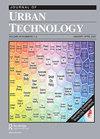网络之外的智慧:内罗毕马萨雷山谷的自动取水机和来自地下的中断
IF 4.6
3区 经济学
Q1 URBAN STUDIES
引用次数: 3
摘要
本文通过研究在非正式城市环境中部署数字项目所产生的多样化和自发的基础设施配置,批判了智能城市主义的非语境化概念。我们对内罗毕马萨雷山谷的自动柜员机进行了实证研究,以突出三种类型的“网络之外的智能”:首先,自动柜员机证明了超越网络城市供水的智能数字基础设施;第二,居民在采用和使用自动柜员机的过程中,扰乱了它们原来的运作,在这个过程中,由于来自下面的干扰,使它们远离了原来的设计;第三,存在非国家和非网络的已有机制的持续表现,有时会整合表明数字技术的异构衔接和来自底层的智能。总而言之,我们主张对智能数字基础设施的南方和其他愿景进行分解,考虑到在不同的城市环境中,智能不仅受到城市建设的霸权和抱负的影响,还受到居民特定于环境和非线性的场所建设过程的影响。本文章由计算机程序翻译,如有差异,请以英文原文为准。
Smartness Beyond the Network: Water ATMs and Disruptions from below in Mathare Valley, Nairobi
ABSTRACT This article critiques decontextualized notions of smart urbanism by examining the variegated and spontaneous infrastructural configurations stemming from the deployment of a digital project in an informal urban setting. We offer an empirical examination of the rollout of water ATMs in Mathare Valley, Nairobi, to highlight three types of “smartness beyond the network”: first, where water ATMs evidence a smart digital infrastructure that transcends the networked urban water supply; second, where residents, in their adoption and use of water ATMs, unsettle their original operation, in the process driving them further away from their original design through disruptions from below; and third, where persistent manifestations of pre-existing mechanisms exist that are non-state and non-networked and sometimes integrate indicating digital technologies heterogeneous articulations and smartness from below. In sum, we argue for unpacking Southern and alternative visions for smart digital infrastructure, considering that smartness, within diverse urban settings, is informed not just by hegemonic and aspirational articulations of city making, but also by dwellers’ context-specific and nonlinear processes of place making.
求助全文
通过发布文献求助,成功后即可免费获取论文全文。
去求助
来源期刊

Journal of Urban Technology
URBAN STUDIES-
CiteScore
8.50
自引率
4.20%
发文量
42
期刊介绍:
The Journal of Urban Technology publishes articles that review and analyze developments in urban technologies as well as articles that study the history and the political, economic, environmental, social, esthetic, and ethical effects of those technologies. The goal of the journal is, through education and discussion, to maximize the positive and minimize the adverse effects of technology on cities. The journal"s mission is to open a conversation between specialists and non-specialists (or among practitioners of different specialities) and is designed for both scholars and a general audience whose businesses, occupations, professions, or studies require that they become aware of the effects of new technologies on urban environments.
 求助内容:
求助内容: 应助结果提醒方式:
应助结果提醒方式:


